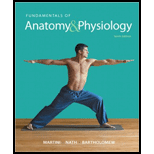
Fundamentals of Anatomy and Physiology - Package
10th Edition
ISBN: 9780134589688
Author: Martini
Publisher: PEARSON
expand_more
expand_more
format_list_bulleted
Concept explainers
Question
Chapter 2, Problem 26RQ
Summary Introduction
To differentiate:
In-between non polar covalent bond, polar covalent bonds and ionic bonds.
Introduction:
Covalent bonds are those bonds in which electrons are shared between two elements. Ionic bonding occurs when one element gives its entire valence electron to other element which creates a positive charge on the donor and negative on the acceptor.
Expert Solution & Answer
Want to see the full answer?
Check out a sample textbook solution
Students have asked these similar questions
Explain the diferences between covalent and ionic bonds.
Discuss the differences between ionic bonds and covalent bonds.
Describe the difference between and ionic bond and covalent bond.
Chapter 2 Solutions
Fundamentals of Anatomy and Physiology - Package
Ch. 2 - Define atom.Ch. 2 - Atoms of the same element that have different...Ch. 2 - How is it possible for two samples of hydrogen to...Ch. 2 - Prob. 4CPCh. 2 - Prob. 5CPCh. 2 - Both oxygen and neon are gases at room temperature...Ch. 2 - Prob. 7CPCh. 2 - Prob. 8CPCh. 2 - Prob. 9CPCh. 2 - Prob. 10CP
Ch. 2 - What is an enzyme?Ch. 2 - Prob. 12CPCh. 2 - Prob. 13CPCh. 2 - Explain how the chemical properties of water make...Ch. 2 - Define pH, and explain how the pH scale relates to...Ch. 2 - What is the significance of pH in physiological...Ch. 2 - Define the following terms: acid, base, and salt.Ch. 2 - Prob. 18CPCh. 2 - Prob. 19CPCh. 2 - Describe lipids.Ch. 2 - Prob. 21CPCh. 2 - Prob. 22CPCh. 2 - Prob. 23CPCh. 2 - Describe a nucleic acid.Ch. 2 - Prob. 25CPCh. 2 - Describe ATP.Ch. 2 - What molecule is produced by the phosphorylation...Ch. 2 - 28. Identify the biochemical building blocks...Ch. 2 - 29. Define metabolic turnover.
Ch. 2 - An oxygen atom has eight protons (a) Sketch in the...Ch. 2 - What is the following type of decomposition...Ch. 2 - The subatomic particle with the least mass (a)...Ch. 2 - Isotopes of an element differ from each other in...Ch. 2 - The number and arrangement of electrons in an...Ch. 2 - All organic compounds in the human body contain...Ch. 2 - A substance containing atoms of different elements...Ch. 2 - All the chemical reactions that occur in the human...Ch. 2 - Which of the following chemical equations...Ch. 2 - Prob. 10RQCh. 2 - A pH of 7.8 in the human body typifies a condition...Ch. 2 - A(n) _____ is a solute that dissociates to release...Ch. 2 - Special catalytic molecules called _____ speed up...Ch. 2 - Which of the following is not a function of a...Ch. 2 - Complementary base pairing in DNA includes the...Ch. 2 - What are the three subatomic panicles in atoms?Ch. 2 - Prob. 17RQCh. 2 - Prob. 18RQCh. 2 - List seven major functions performed by proteins.Ch. 2 - (a) What three basic components make up a...Ch. 2 - What three components are required to create the...Ch. 2 - If a polypeptide contains 10 peptide bonds, how...Ch. 2 - Prob. 23RQCh. 2 - Prob. 24RQCh. 2 - What is a salt? How does a salt differ from an...Ch. 2 - Prob. 26RQCh. 2 - In an exergonic reaction, (a) large molecules are...Ch. 2 - Prob. 28RQCh. 2 - Prob. 29RQCh. 2 - An atom of the element calcium has 20 protons and...Ch. 2 - A certain reaction pathway consists of four steps....Ch. 2 - Prob. 32RQCh. 2 - Prob. 1CCCh. 2 - Prob. 2CC
Knowledge Booster
Learn more about
Need a deep-dive on the concept behind this application? Look no further. Learn more about this topic, biology and related others by exploring similar questions and additional content below.Similar questions
- Explain the difference between an ionic bond and a covalent bond.arrow_forwardWhat kinds of bonds often control the shape (or tertiary form) of large molecules such as proteins? a. hydrogen b. ionic c. covalent d. inert e. singlearrow_forwardName the difference between ionic, polar covalent, & non-polar covalent bonds and their solubility rules.arrow_forward
- List three main types of chemical bonds, and give an example of each.arrow_forwardDifferentiate between covalent and ionic bonds:arrow_forwardClassify each of the following bonds as nonpolar covalent, polar covalent, or ionic on the basis of electronegativity differences.a. C—Ob. Na—Clc. C—Id. Ca—Sarrow_forward
arrow_back_ios
SEE MORE QUESTIONS
arrow_forward_ios
Recommended textbooks for you
 Human Biology (MindTap Course List)BiologyISBN:9781305112100Author:Cecie Starr, Beverly McMillanPublisher:Cengage Learning
Human Biology (MindTap Course List)BiologyISBN:9781305112100Author:Cecie Starr, Beverly McMillanPublisher:Cengage Learning

Human Biology (MindTap Course List)
Biology
ISBN:9781305112100
Author:Cecie Starr, Beverly McMillan
Publisher:Cengage Learning

Macromolecules | Classes and Functions; Author: 2 Minute Classroom;https://www.youtube.com/watch?v=V5hhrDFo8Vk;License: Standard youtube license